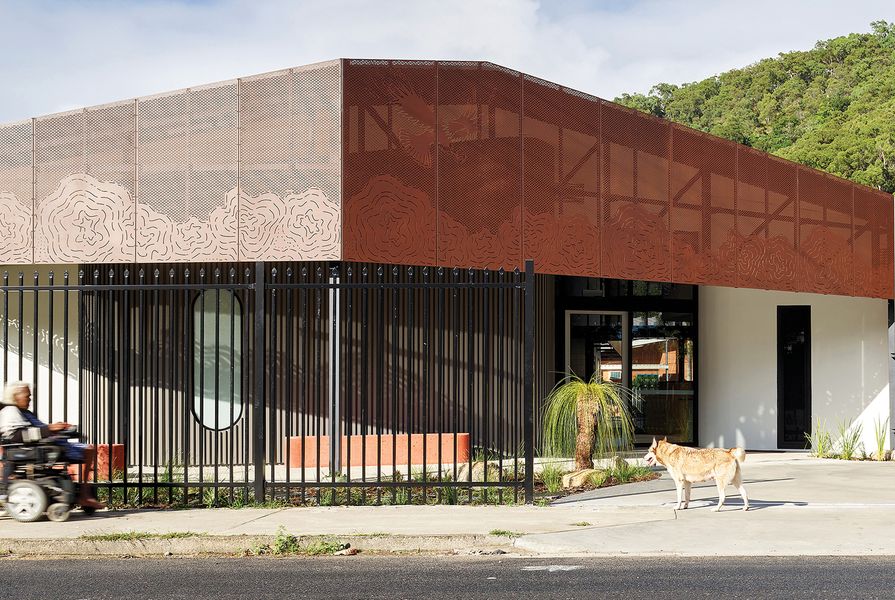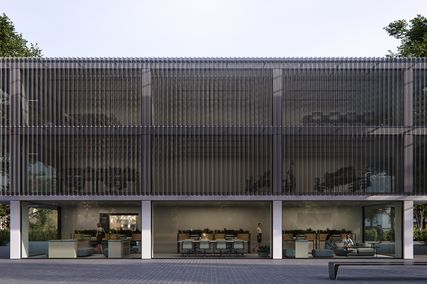When People Oriented Design (POD), with Coburn Architecture, won the bid to design the new Gurriny Yealamucka Health and Wellbeing Centre (GYHWC) at Yarrabah, on the lands of the Gunggandji and Yidinji peoples, the question for co-director Shaneen Fantin was not how to meet what the contract required, but, “How far can we build on what the contract was asking us to do?” The practice identified opportunities to maximize Indigenous economic benefits at multiple levels, exceeding the requirements for Indigenous employment, training, suppliers and engagement – and all within a tight contractual timeframe. The health centre was delivered without excessive cost blowouts and ahead of its scheduled delivery by the Indigenous-owned company H. C. Building and Construction. This was no small feat, particularly with the impact of COVID affecting building supply chains, construction programs and labour continuity.
The achievements of GYHWC give us a glimmer of hope that things are changing for the better, but an industry-wide engagement is needed to affect the ambitious changes envisioned. It would be nationally embarrassing, to say the least, to hang an entire industry on a handful of “Indigenous identified” projects, because the industry has so much more room to revolutionize.
You may be working in an Australian architectural practice that has encountered increasing government requirements to achieve social and economic policy goals. These are aimed at reversing Indigenous disadvantage and discrimination in government contracting practices. Many of the recent changes are modelled on the success of minority-targeted economic initiatives in the United States. These have been morphed into localized policies in the United Kingdom, Canada, South Africa and Australia, where governments and their funded institutions of all persuasions are seeking to stimulate affirmative action, not only in employment but also in entrepreneurial activity.
“If you want community ownership, and you want community to help look after the building, it’s about having community input in the design, in building it, in planting the trees …” says Gurriny Yealamucka Community Control Health Services chief executive Suzanne Andrews.
Image: Scott Burrows
In Australia, the requirements are expressed as either percentages or qualitative targets. Indigenous employment and the growing of First Nations businesses to enhance economic wellbeing are obligatory not only for Indigenous identified building and construction projects, but across all government procurement sectors. Spurred on by Reconciliation Action Plans (RAPs), 1 other institutions and entities – such as the higher education and private sectors – are recalibrating their own procurement practices. 2 Three relevant government policies driving these changes are the Indigenous Business Exemption (IBE, 2011), the Indigenous Opportunities Policy (IOP, 2011) and the Indigenous Procurement Policy (IPP, 2015), 3 which all target Indigenous entrepreneurs, including employment and training outcomes.
Given the profile of Indigenous-owned businesses and the industries in which they specialize, it would be unrealistic to expect wholesale changes overnight. Between 2015 and 2019, Commonwealth departments purchased more than $1 billion worth of goods and services from Indigenous suppliers. In 2016, it was conservatively estimated that 17,900 Indigenous owner-managers operated in Australia, with 27.5 percent of these being in the construction industry. Many are small businesses with less than 20 employees, but they differ from non-Indigenous businesses in one key area – they are much more likely to hire Indigenous employees. 4
Of course, this relatively small number of businesses and workers can’t service the entire nation. Identifying contractors who demonstrate genuine relationships with an Indigenous supply chain and labour force is challenging. Supply Nation, a database of Indigenous businesses, has a mission to facilitate supplier diversity. It certifies Indigenous businesses with more than 50 percent Indigenous ownership. The builder for GYHWC, H. C. Building and Construction, is on the database. A medium-sized contractor with 67 employees, H. C. has a workforce of which more than 40 percent are Indigenous and it takes an active role in recruiting Indigenous apprentices, qualified tradespeople and suppliers . Two additional first-year apprentices from Yarrabah were engaged on the health clinic project and, now that the project is com-plete, have been kept on by the builder to work on other sites.
According to Suzanne Andrew, chief executive of Gurriny Yealamucka Community Control Health Services, “Local input is not just about designing the building, it’s also about ensuring financial return to the community.” At Yarrabah, “there was a good vibe in the community around this building” because the community was aware that it was being undertaken by an Indigenous company – “giving jobs to mob.” H. C. gave back to the community by buying from local shops and sponsoring the local football team. The project also included a significant budget for local artwork.
The entire facilities management team at the centre is employed and paid through Gurriny Yealamucka Health Service.
Image: Scott Burrows
Anyone who follows Indigenous architectural projects may be aware that not all projects achieve the level of social and economic impact attained by GYHWC. I want to be careful about giving the impression that the small and relatively marginal sub-industry of “Indigenous projects” should be tasked with doing the economic heavy lifting for Australia’s estimated $360-billion building and construction industry. Not every project can engage an Indigenous builder – but other opportunities to increase economic outcomes are within reach. A considerable challenge in preparing this article was the accessibility of information and data on Indigenous economic outcomes in building and construction. The metadata reported by the Australian Bureau of Statistics maps national measures but lacks detail. It’s relatively easy to quantify the national value of building and construction to GDP, but it’s extremely difficult to track the real economic and social impacts achieved for Indigenous Australia, particularly in remote regions of high need.
There are several reasons for this. One is that government requirements to report on Indigenous economic outcomes have not been consistent. Until recently, governments have been fixated on deficit statistics and “closing the gap,” and more focused on employment and training than entrepreneurship. Another reason may be the somewhat murky label of “Indigenous identified” project, which, at least in the government health sector, is geographically rather than socially defined. Projects located in remote and very remote places are required to meet economic benefits standards, while those in regional towns and capital cities are not. The discrete Indigenous community of Yarrabah is considered “urban,” but it lacks any of the infrastructure benefits and social advantages of a town or city. Fifty kilometres south-east of the regional city of Cairns, it is accessible only by a circuitous route through a coastal mountain range.
Over the last decade or so, innovative procurement practices promised ambitious gains in Indigenous employment and business development in regions of need. The federally funded National Partnership Agreement on Remote Indigenous Housing (NPARIH), which allocated $5.5 billion over 10 years to June 2018, explicitly targeted economic participation. Although training and employment achievements were mixed, a review of the program found that the short-term (three-year) funding cycles actively undermined sustained investment. Also, the use of local labour for building, tenancy and maintenance by upskilling local workforces to perform non-trade work needs to be a priority before programs such as this begin. Investment in remote Indigenous businesses was less notable in the early stages of the NPARIH, but it increased dramatically in 2015–16 as a result of specific procurement policies. 5
Barangaroo’s 22-hectare waterfront renewal in Sydney’s CBD was a missed opportunity by an industry at the beginning of a cultural awareness journey. Although its worth was more than $6 billion, the public–private partnership was not fully engaged with diverse suppliers. As the developer of Barangaroo South, Lendlease found that there was a need to build a talent pipeline to achieve employment parity. Small but measurable outcomes in Indigenous stakeholder engagement, employment and artistic commissions were achieved. Emerging artist talent was also fostered. But, with on-the-run strategies and without specific policies, Indigenous economic benefits amounted to a miniscule percentage of the overall budget allocation. Examples such as this demonstrate that capability needs to be built within corporate, state and Indigenous businesses to create effective implementation strategies for procurement policies and to allow time for training ahead of program delivery.
Until relatively recently, government supplier diversity was not pursued or intensely monitored. In the last five years, specific tender requirements to engage Indigenous contractors, suppliers, labour and trainees have increased exponentially. Although the outcomes achieved on GYHWC were a consequence of responding to tender demands, architectural practices like POD would have advocated for such outcomes as a matter of core business and ethos. Practices who share similar approaches and protocols rarely achieve only what contractual obligations require; they often exceed specified architectural services. POD works closely with funding agencies and treats Indigenous stakeholders like clients. They push and pull to maximize outcomes by offering to fill gaps in skills, engage with Traditional Owners and Indigenous administrators, and find ways for projects to give back to the community – for example, by recycling demolished building components to provide precious resources for Traditional Owner self-built structures on Country. (This gesture gained incredible social currency for GYHWC, garnering greater community support and showing insight into a local need not explicitly identified in procurement policies.) According to Shaneen Fantin, the process requires architects “to step out of their immediate role, of seeing place as geography, topography, climate … and to see it as people and culture and community and stories. It’s about asking, ‘How is this project part of the fabric of that community?’”
“We’d really like to do something, but where do we start?” I’ve heard this question a lot recently. Every architectural practice, developer and contractor can start by examining how they currently do business with Indigenous peoples, whether they are clients and stakeholders or suppliers. Check whether your modus operandi aligns with collaboration, co-planning, co-design and long-term economic outcomes. A healthy way to self-reflect on your business practices is to undertake an RAP. Examine the good others are doing and evaluate whether these approaches and targets are achievable in your practice. Consult Supply Nation and make use of reputable training organizations and agencies such as Career Trackers. Not everyone can achieve the outcomes achieved on GYHWC, but if you start with the standard and aim to exceed it on each and every subsequent project, you’ll be able to measure your own change.
1. See University of Sydney, Wingara Mura Design Principles, 2016; Queensland University of Technology, Campus to Country, 2020; Carroll Go-Sam, Kelly Greenop, Kali Marnane and Theresa Bower, Campuses on Countries: Aboriginal and Torres Strait Islander Design Framework at The University of Queensland, 2021; University of Queensland, Campuses on Countries: Aboriginal and Torres Strait Islander Design Framework Engagement Report, 2021.
2. Approximately 1.5 million Australians work or study in an organization that has a Reconciliation Action Plan, including the organizations Lendlease, Mirvac and Stockland.
3. Leanne Cutcher, Jarrod Ormiston and Caitlin Gardner, (2020) “‘Double-taxing’ Indigenous business: exploring the effects of political discourse on the transfer of public procurement policy,” Public Management Review, vol 22 no 9, 2020, 1398–1422, doi.org/10.1080/14719037.2019.1679235.
4. Siddarth Shirodkar, Boyd Hunter and Dennis Foley, “Ongoing growth in the number of Indigenous Australians in business,” Centre for Aboriginal Economic Policy Research Working Paper 125, 2018, Centre for Aboriginal Economic Policy Research (CAEPR), ANU College of Arts and Social Sciences, openresearch-repository.anu.edu.au/handle/1885/148675.
5. Commonwealth of Australia, Department of Prime Minister and Cabinet, Remote Housing Review, A Review of the National Partnership Agreement on Remote Indigenous Housing and the Remote Housing Strategy (2008-2018).
Source

Discussion
Published online: 30 May 2022
Words:
Carroll Go-Sam
Images:
Scott Burrows
Issue
Architecture Australia, May 2022




















